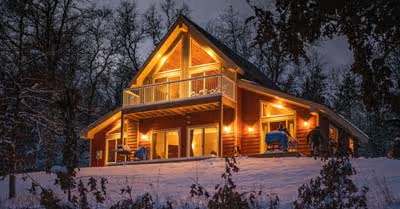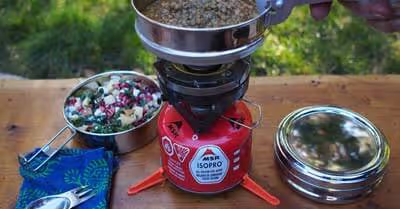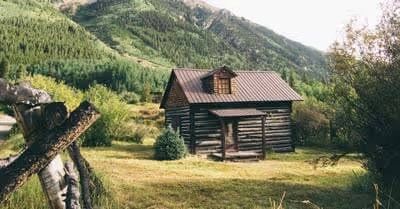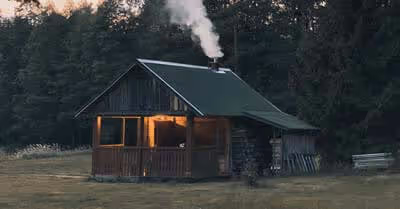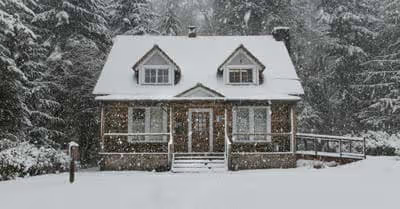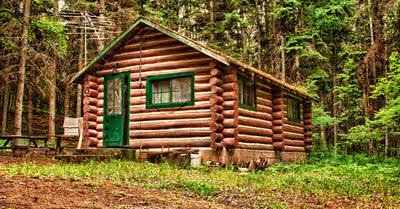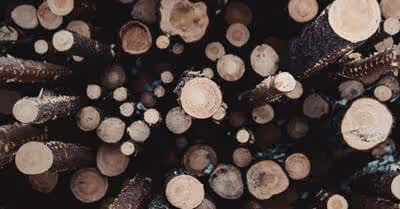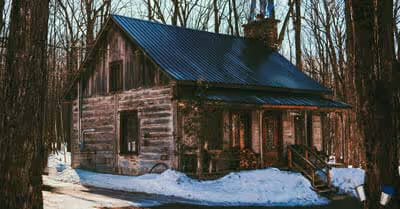Table of Contents
Why Should You Stain Instead of Painting a Log Cabin?
Whether to stain or paint is entirely a personal choice. After all, some people will prioritize the aesthetic appeal painting brings while others will prioritize longevity. Your cabin may look livelier, brighter, and appealing when painted with bright, attractive colors, but this may not protect your log in the long run.
In fact, painting may even do the complete opposite of what you hoped to achieve. While paint is known to protect other building materials such as metals by preventing rusting, when applied in wood, it destroys it. The fact is that log cabins are exposed to harsh weather conditions that create a favorable environment for rotting. And now, when you paint, you accelerate this process.
Why Does Wood Rot?
Trees are living things, and when a living object dies, it starts to rot. And since logs were part of trees in the woods, when they are cut and shaped to create your attractive holiday home, they will end up rotting faster than they should if not taken care of.
In other words, wood is prone to rot, but there are several ways of slowing down rotting.
The three major culprits for wood rot are fungus, oxygen, and moisture. If you eliminate one of these three ingredients, wood will not rot. Fungus is always present around us, and thus we cannot eliminate it, regardless of the number of paints you apply. Oxygen is another freely available element that we cannot control.
Of the three elements, moisture is the only one we can prevent. Yes, you can keep your cabin logs dry, although this will call for some work.
When these three conditions are present, your cabin logs will begin to rot. At first, it may not be dangerous, but if left to spread, rot can have a fatal ending, especially if the cabin ends up collapsing when you are inside. That's why it is important to prevent rotting from taking place in the first place.
Why Painting a Log Cabin Doesn't Prevent Rotting
The main reason many people paint their log cabin houses is to improve their aesthetic appeal and block water from causing damage to the log. At first, this makes sense. After all, we said earlier that given oxygen and fungus are out of our control and thus will find their way into the logs, paint will prevent water from coming into contact with the logs, and thus save them from rotting.
However, on the contrary, painting creates a favorable condition for rot to occur as it brings the third ingredient for rotting on board (moisture).
In the first few months, quality paint will keep water at bay. However, with time, it tends to chip off, which means that your logs will be exposed to raindrops. This means moisture will start finding its way into the logs and will just sit there.
You know what will happen, now that oxygen, fungus, and moisture are on wood. If you have ever left a log lying on the ground for several months, you know that the side lying on the ground will most likely show signs of decay. This is what happens when your painted logs trap moisture inside.
What happens when the logs start to rot? They start getting soft and thus don't insulate well. Also, they start getting weak and thus allow wind and rainwater to sip inside. Rot spreads fast, and if you fail to control it, your whole cabin will soon lose its structural integrity, and may even require a complete rebuild. You don't want that, do you?
If you spot a rotting log earlier, you should act fast if you want to save on repair costs. You may have to replace several logs that are affected, but this is a difficult and expensive process. You may need to get new logs that are cut just right to replace the missing ones. This is a whole lot of work, which is why you should do things right in the first place- DO NOT PAINT YOUR CABIN.
What Is the Best Solution? Stain.
Staining is entirely different than painting and works differently. With paint, a coating seals your logs, but with stain, it soaks into your logs, giving it a nice, clear appearance while preserving the logs.
There are many advantages of staining over paint for log cabins.
First, it protects the natural stain of wood by not sealing moisture in the wood. Stain repels a lot of moisture brought by snow, frost, dew, and rain. In fact, it makes wood to be more resilient against weather elements and does this without entirely sealing the logs. Your logs will stay dry even when there is a lot of moisture on the outside. And of course, dryer logs rot less.
Paint speeds up the process of rotting as it traps moisture inside a log. Also, it prevents logs from breathing, which means that they will eventually break down since they are made of organic material.
Now that we have agreed that stain is the best option if you want to protect your log cabin and enhance its appearance let's talk about what to use.
How to Choose the Right Stain For Your Log Cabin
Choosing the right stain for your log cabin is the most fun part of the staining process; however, for some, it is the most stressful. But we are here to help make the process more fun.
Here are important factors to consider when choosing the right stain;
Exterior vs. interior stain
There are stains designed for exterior applications, while others are made for the interior application. Those designed for exterior applications usually have UV protection abilities to keep your logs from fading. The most important thing is to choose the right stain.
Oil-based stains or water-based stains?
There are two main categories of stains, with each having a different appearance and mode of application. Let's discuss both;
Oil-based stains
These bring out the natural grain of the wood and tend to have a more natural appearance since they tend to soak into the wood. Also, they look beautiful and tend to be the most durable. However, on the downside, they tend to be messy to apply.
Water-based stains
These, too, tend to be durable and relatively easy to apply and maintain. They tend to be less messy to apply.
In addition to these two main categories, there is a less popular category;
Hybrid oil-water stains
These stains have both water and oil properties. They normally have resins but can be cleaned up with water and soap. They soak into the wood and leave a more natural finish.
Color
Another thing to keep in mind when choosing a stain is color, and here are a few factors to keep in mind when choosing a color for your preferred category of stain;
- Choose a stain color that you will always fall in love with for years to come. Changing a stain color is an uphill task; it is not as simple as changing paint color since stain soaks into the wood
- Stain gets darker with each coat you apply. Therefore, if you don't want an overly darker stain, choose a lighter stain than what you have in mind as the final color will darken after 1-2 coats
- Test out the stain color on a sample area before you paint the whole cabin. Stain produces a different finish on different types of woods, and thus may not produce exact color as the one printed on its swatch
- If you want to re-stain a cabin that had a dark-colored stain, it will be harder to make a newer coat look evenly brushed, especially if it is a lighter stain
With these factors in mind, you are now in a better position to choose the right stain for your log cabin.
How to Prepare You Log Cabin for Staining
Preparing your log cabin for staining is as important as staining it. Proper preparation ensures that your stain, once applied, will protect your logs as long as possible.
That's why it is important that you don't skip these steps;
Clean the logs
Dust, pollen, or dirt on logs can prevent the stain from turning out clean and smooth. Also, they make the stain application process hard. That's why it is important that you clean them first. You can clean them using a pressure washer.
Dry your wood
Before applying your stain, it is important that you dry your logs. Moisture levels should be below 18 percent so that the stain soaks well into the wood.
Keep an eye on the weather
You should stain on days that are not too humid or wet- the ideal temperature for staining should be between 50-90 degrees. If possible, avoid staining in direct sunlight as this can make the stain look blemished.
Now, let's get to the real business- staining your log cabin.
How to Stain Your Log Cabin
This should be the exciting part.
Step 1- test the stain in a sample, inconspicuous area
As we mentioned earlier, stains have different finishes on different types of woods, which is why you should test it in an area that is inconspicuous to ensure it is the color you wanted. Make sure you apply the stain severally to see the final picture of its color.
Step 2 - Apply the first coat
After you have verified it is the stain color you want, it is time to apply your first coat of stain. You should follow these best practices when applying stain;
- If indoors, ensure that the rooms are well-ventilated
- Go through all manufacturer's instructions and follow them
- Work horizontally
- Apply the stain with a heavy hand and brush back strongly to ensure it turns out even
Step 3- apply at least two more coats
After you are done with the first coat, allow it to dry for 24 hours before going back to the starting point and applying another coat. Make sure you brush the stain in a fourth-back manner so as to create a consistent look. Apply at least two coats of stain for longevity.
Step 4- apply a topcoat
Topcoats can be colored or clear. They are a great investment since they lengthen the life of a stain. When looking for a topcoat, choose one that has the ability to protect your logs from UV rays.
That's it! Your cabin should be looking all posh and attractive now. Make sure that you give it a gentle power wash once or twice a year and a re-stain every 2-5 years.
For best results, we recommend that you look for a local expert in log stains. These experts will be in a better position to advise you on the best stain for your locality and will do a better job of transforming your cabin appearance with stain.
Recent Articles



